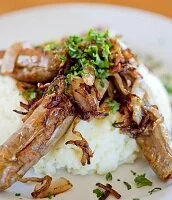Staple Foods
Bread: commonly served with most dishes, even many that already contain potato
Potato: this food is found in most hot dishes and is a true staple and base in the Irish diet
Regional Variations & Specialties
Black Pudding: blood and barley with various seasonings
Coddle: layered bacon and pork with potatoes and onions
Southwest Ireland: region experimenting with traditional Irish dishes served in a French style; it is fairly distinct
Stobhach: or "Irish Stew" is the national dish and consists of lamb or mutton with potatoes, carrots, onions, and parsley
Dining Etiquette

Sausage with mash
Dining rules in Ireland are similar to those in the United Kingdom, but tend to be more relaxed. The Irish may arrive a couple minutes late and formalities are generally limited in scope, although turning down an alcoholic drink may offend your local host.
If you're eating in a local's home bring a small gift and try everything that's prepared as turning down food can be somewhat rude, but the Irish are more understanding than most if you truly cannot eat something for whatever reason. Unlike many European countries, if you're not eating, keep your hands out of sight and place them on your lap.
As you eat, be sure to eat in the continental style (knife in the right hand, fork in the left) and use the small plate on the table as a discard tray for your potato peelings. As the meal concludes the inviter should pay for everyone if at a restaurant (although for drinking, generally everyone buys a round for the group) and if you're at a local's home, offer to help clear the dishes when the meal is finished.